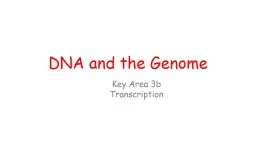

3b Transcription Learning Intentions Transcription of DNA State the location of transcription State 4 things that must be present for transcription to occur Describe the process of transcription ID: 780092
Download The PPT/PDF document "DNA and the Genome Key Area" is the property of its rightful owner. Permission is granted to download and print the materials on this web site for personal, non-commercial use only, and to display it on your personal computer provided you do not modify the materials and that you retain all copyright notices contained in the materials. By downloading content from our website, you accept the terms of this agreement.
Slide1
DNA and the Genome
Key Area
3b
Transcription
Slide2Learning Intentions
Transcription of
DNA
State the location of transcription
State 4 things that must be present for transcription to occur
Describe the process of transcription
Describe the role of RNA polymerase
Identify introns and exons on a diagram
Explain what introns are
Explain what exons are
Explain the difference between primary and mature RNA transcripts
Describe RNA splicing
Slide3Transcription
Slide4DNA can be split into segments called genes and each gene codes for proteins.
The DNA is unable to leave the nucleus of the cell so how does the information for protein synthesis get to the ribosome?
A copy of the DNA is made by producing mRNA during the process of transcription
Transcription is the synthesis of mRNA from a section of DNA in the nucleus of a cell
Transcription
Slide5Transcription
However, not every gene is switched on in a cell and some genes can be switched on or off depending on the needs of the cell.
How then is a particular gene expressed when required?
Slide6Transcription
DNA is made up of 2 types of regions…coding regions called
exons
and non-coding regions called
introns
.
During transcription a copy of both the introns and exons within the gene to be transcribed are made into
primary mRNA.
This is then altered to produce the
mature mRNA
To ensure only the required protein is made, the start and end of every gene has a specific sequence called the
promoter region
and the
terminator region
Slide7Promoter: Start of a gene
Terminator: End of a gene
Gene to transcript and transcribe
Slide8Promoter and Terminator DNA Sequences
Much like DNA replication, a section of the DNA (
gene
) has to unwind and an enzyme bind to begin transcription.
The enzyme involved in transcription is
RNA polymerase
and it recognises and binds to the DNA at the promoter sequence.
RNA polymerase moves along the DNA unwinding the double helix and braking the hydrogen bonds between the DNA bases.
Slide9Promoter and Terminator DNA Sequences
It then matches RNA nucleotides to the corresponding DNA nucleotides and thus synthesises a primary transcript of mRNA by complimentary base pairing (
5’ to 3’)
until it reaches the termination sequence.
As thymine is not present in RNA
, Uracil
in the RNA is complimentary to adenine
A
t this point the mRNA separates from the DNA to produce the
primary mRNA transcript
Slide10Transcription of DNA into mRNA
RNA polymerase binds to the promoter sequence of the gene to be copied and begins to unwind it
The enzyme then forces
t
he
DNA strands
apart by breaking the weak
hydrogen bonds between the base
pairs (this is known as
initiation
)
Slide11Transcription of DNA into mRNA
Free RNA nucleotides pair up with complementary bases on the DNA strand (remember: U instead of T) and weak hydrogen bonds form between the complementary bases
The RNA polymerase begins to link RNA nucleotides, forming strong chemical bonds between
them
(
elongation
)
The
weak hydrogen bonds break separating the DNA from the newly formed
primary mRNA
mRNA = messenger RNA
Slide12Transcription of DNA into mRNA
The RNA polymerase reaches the termination sequence and separates from the DNA having produce the
primary mRNA transcript
(
termination
)
Weak
hydrogen bonds then form between the two DNA strands, the DNA then winds up into the double helix again.
transcription animation
Slide13Slide14RNA Splicing
1 gene contains a mixture of introns (non-coding sequences) and exons (coding sequences). This means the primary transcript of mRNA still has a mix of introns and exons.
However, the protein is coded for by the exons only so before the mRNA can be translated into the protein, the introns (and possibly some exons) must be cut out to produce the
mature mRNA
.
The introns (& exons) are cut out and the remaining exons are
spliced
together as shown
Splicing animation 1
Slide15This gene is made up of 3 exons separated by 2 introns
The introns are cut out and the 3 exons joined together to make the
mature mRNA
.
The order of the exons does not change
RNA Splicing
Slide16Primary transcript
Primary transcript
Mature transcript